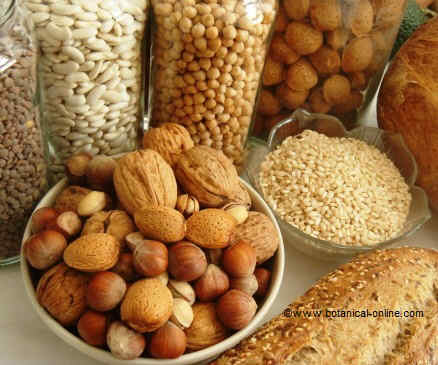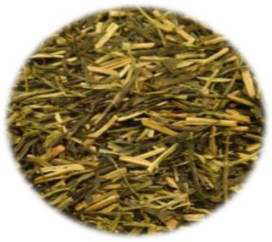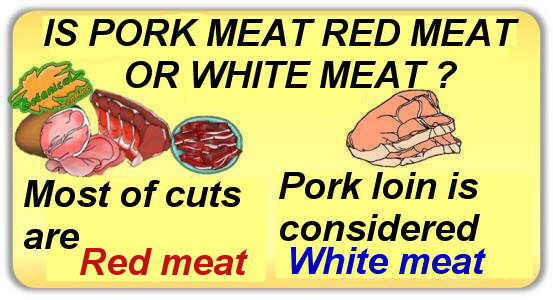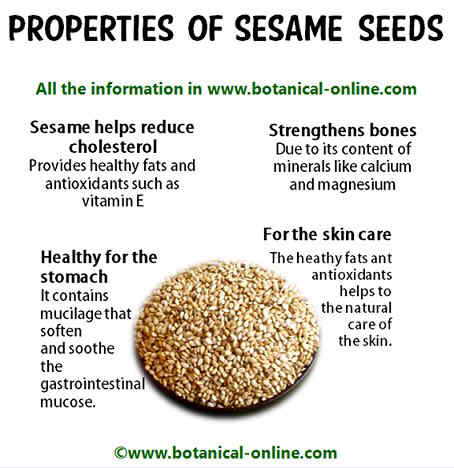Contents
What are carbohydrates or carbs?
Carbohydrates, also called carbs or saccharides, are a group of organic compounds containing hydrogen, oxygen and carbon. Although its name might suggest it, they are not really hydrated carbon molecules.
They are the most abundant organic compounds in nature. They appear in the animal and plant kingdoms, from the photosynthesis of plants and bacteria from carbon dioxide and water with the help of sunlight.
Carbohydrates constitute, along with proteins and fats, the main nutrients.
Properties of carbohydrates
- Energy source: The main function of carbohydrates is to provide and store energy. Carbohydrates give the necessary energy (calories) for the body to function properly.
The body needs approximately 100 g carbohydrates daily. Any low carbohydrate diet should provide at least these 100 g. of carbohydrates. Less than this amount of carbohydrate in the diet is unhealthy and can produce side effects like the yo-yo effect.
Carbohydrates provide fewer calories than fats: 1 g. of carbohydrate produces 4 Kcal. and 1 g. of fat produces 9 Kcal.
Carbohydrates, along with lipids or fats and proteins provide the fuel that burns to get the necessary energy (calories) for the body to function properly.

What are carbohydrates for? Carbohydrates provide energy. Thanks to them, we get immediate energy for the organism that allows us to live and do the daily work. Carbohydrates are made up of glucose. Glucose is found in the blood and is used by all cells for energy. It is a slow and lasting source of energy. Therefore, carbohydrates are very important and we have to include them in every meal.
- Nervous system: Carbohydrates are composed of molecules of sugars. One of the main functions of glucose is to feed the blood cells (erythrocytes) and those of the brain (neurons), since these cells can not obtain energy from any other substrate (neither fats, nor proteins). Without these foods in the diet, bodily functions are destabilized and metabolism changes such as ketosis.
All carbohydrate-rich foods also contain B vitamins, which have energy functions and tone the nervous system. These foods are very suitable when there is stress, anxiety or nervousness.
- Intestinal flora: Carbohydrates are highly fermentable and are very healthy to help maintain a healthy intestinal flora. This leads to an improvement in intestinal health, with consequent better absorption of nutrients and increased immunity.
- Other functions of carbohydrates: Carbs can perform other non-energy functions. Sometimes carbohydrates have other functions. For example: Structural function, as the cells that form the structure of plant cell wall or chitin that forms the outer structure of the arthropod. They also can be part of the genetic code, as with the ribose. The glycocalyx is a carbohydrate with a very different function because it allows the cells to recognize each other and distinguish those that may be invasive or diseased.
Where do we get the carbohydrates from?
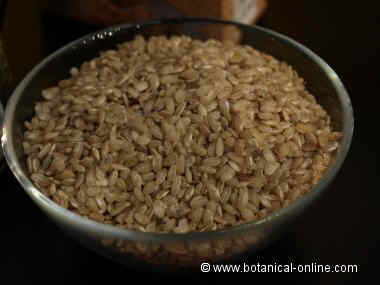
Cereals such as rice, or legumes such as lentils are carbohydrate-rich foods
Most carbohydrates are obtained from plant foods. They are very abundant in cereals, such as rice, wheat or corn and in the food we get from them, such as bread, cookies, breakfast cereals, pasta, etc.
Legumes are also very rich in carbohydrates. Among them are soybeans, beans, chickpeas, lentils, etc.
Types of carbohydrates
The following table shows the main types of carbohydrates and some of its features according to a dietary standpoint.
| Starch | Sugars | |
| Function in vegetables | They constitute the elements of reserve of vegetables (starch) | They use them to form the vegetal structure. (They are classified in simple – fructose, glucose and galactose- and complexes (maltose or sucrose.) |
| Main parts of the plants that contain them | Plants with tubers: potatoes, sweet potatoes, tiger nuts, tapioca, etc. Cereals: wheat, barley, oats, rice, etc. Legumes: peas, beans, lentils, chickpeas, string beans, soybean, etc | Fruits: apple, strawberry, cherry, fig, orange, pear, etc Sugar (Sugar cane, beet) |
| Hydrates of animal origin | Milk and eggs | |
| Ways of digesting them | Must be cooked before eating to help assimilate them. Are indigestible if eaten raw. Digestion is slow and the contribution of sugar to the blood becomes gradually. | They can be eaten raw or cooked, are easily accessible and provide quick energy. |
| How does the body assimilate them? | In the body they break down into glucose which is used for combustion cell, or as a reserve substance in the form of glycogen in the liver or muscles. The remaining amount is stored as reserve substance in the form of fat. | |
Carbohydrate classes
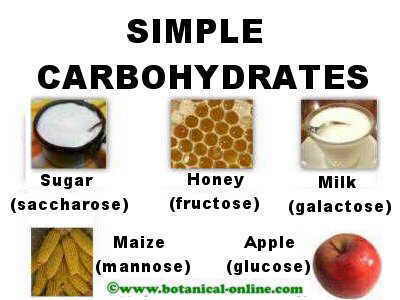
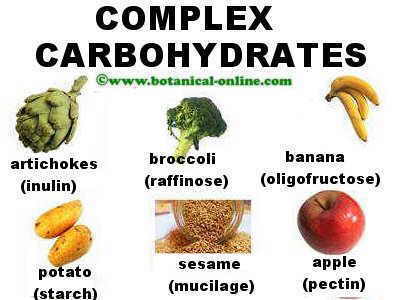
There are two types of carbohydrates: simple and complex carbohydrates
- Simple carbohydrates: From a scientific point of view, the simple carbohydrates are exclusively made up of simple sugar molecules. They are known as monosaccharides.
Monosaccharides are simple carbohydrates. They contain between 3 and 6 carbon atoms and are characterized by not decomposing into simpler ones, that is to say they do not hydrolyze.
From a dietary standpoint, monosaccharides (single sugar molecule) and disaccharides (consisting of two simple sugar molecules together) can be considered simple carbohydrates. Disaccharides hydrolyze (break down) producing two monosaccharides.
- Complex carbohydrates: From a scientific point of view, complex carbohydrates are composed of disaccharides, oligosaccharides and polysaccharides as opposed to simple carbohydrates or monosaccharides.
Oligosaccharides are carbohydrates that contain between 3 and 10 monosaccharides. Polysaccharides are carbohydrates are formed by the union of many monosaccharides or disaccharides.
How many carbohydrates to take?
Carbohydrates must play a fundamental role in the daily diet as energy suppliers. Are generally recommended for the daily diet the following proportions of foods that provide energy:
- 55% of carbohydrates (glucides)
- 30% of fats (lipid)
- 15% of protein
However, the importance of these foods in the diet is so crucial that the proportion of carbohydrate versus fat and protein could still be higher. According to the World Health Organization foods rich in carbohydrates should cover between 55 and 75% of all energy foods included.
The required calories of each individual depend on the type of work he performs, but in general, performing moderate activity, an adult male needs between 2500 and 4000 Kcal. and a woman between 2100 and 3000 Kcal.
Taking into account that the calories of carbohydrates should represent 55% of this energy value, at least one should take a cereal plate and 100 g. of bread a day (equivalent to 1,000Kcal).
Metabolism of carbohydrates
The proper functioning of the metabolism of carbohydrates, along with the proper metabolism of other nutrients, allowing the body to enjoy good health. Properly digesting and assimilating carbohydrates primarily allow us to obtain energy from food in a rational manner.
Thus the body may have appropriate biological fuel to provide the necessary energy to cells, thus allowing the muscle work as a series of activities of the basal metabolism (maintaining proper body temperature, to achieve the proper functioning of the intestine, achieve sufficient blood pressure in the arteries or the proper function of neurons, keeping the breath, etc)
In addition to providing adequate energy, carbohydrates can be stored as glycogen from excess glucose in the liver and muscles. The body may have this book in emergency situations by transforming it back into glucose.
The incorrect metabolism of carbohydrates can be responsible for some metabolic diseases. Among them, obesity is one of most common. A very slow metabolism, along with other factors such as sedentary lifestyle, poor diet or stress, are the most common causes of overweight or obesity.
In this case, it so important to calculate the calories that give us energy foods such as choosing foods rich in carbohydrates suitable to provide us an adequate calories more efficiently. These practices if they are carried out regularly, along with other dietary and life as an adequate daily physical activity, are part of what is known as accelerating the metabolism, a process that allows “burn” more calories so that they are not stored in the form of fat.
Simple carbohydrates in front of complex carbohydrates
Among the carbohydrates, it is best to choose as food complex carbohydrates to simple carbohydrates. That is to say, those that are absorbed more slowly in front of those quick absorption.
Foods such as sugar, bakery products, products made with refined flour, sweets, ice cream or fruit and fruit juices are high in simple carbohydrates. All of them, except for fruit and fruit juices are recognized dietetically as “empty calories” or “zero calories” foods; it means that is high in calories but lacks other much needed nutrients for good health. (More information on this topic)
Empty calories and refined sugar
Foods like refined sugar, baked goods, soft drinks, jelly beans, products made with refined flour, sweets, ice cream or fruit and fruit juices are rich in simple carbohydrates.
All of them are dietetically recognized as “empty calories” or “zero calories”; ie contain many calories but lack other nutrients much needed for good health.
The importance of cellulose
Cellulose is a complex carbohydrate such that plants use to build your frame. Human enzymes can not break them down so they are not digestible and are passed to defecation in the form of fiber.
The importance of vegetal fibers in the health has been verified because they avoid constipation, eliminates toxins from the intestines and create a feeling of fullness helping to eat fewer calories favoring the non-appearance of obesity. (More information on benefits of dietary fiber)
The main vegetal fiber suppliers are the dried fruits, fleshy fruits, vegetables, and legumes.
![]() More information on carbohydrates.
More information on carbohydrates.

